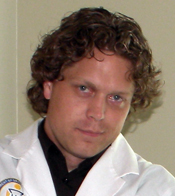Resumo
Definição
História e exame físico
Principais fatores diagnósticos
- golpe direto na cabeça ou desaceleração da cabeça por uma força impulsiva
- trauma cerebral anterior, uso de substâncias ou abuso de álcool
Outros fatores diagnósticos
- cefaleia
- sensação de confusão/lentidão
- tontura/problemas de equilíbrio
- dificuldades de memória
- vômitos/náuseas
- dor cervical
- exame neurológico físico normal
- anormalidades nos exames neuropsicológicos
Fatores de risco
- traumatismo cranioencefálico
- trauma cerebral prévio
- uso indevido de bebidas alcoólicas e drogas
- pouca força no pescoço
Investigações diagnósticas
Primeiras investigações a serem solicitadas
- diagnóstico clínico
Investigações a serem consideradas
- tomografia computadorizada (TC) do crânio
- ressonância nuclear magnética (RNM) de crânio
Novos exames
- tomografia por emissão de pósitrons (PET), TC por emissão de fóton único (SPECT)
- tecnologias de RNM multimodais
Algoritmo de tratamento
lesão cerebral traumática leve confirmada
Colaboradores
Autores
Luke C. Henry, PhD

Assistant Professor
Department of Neurological Surgery
Senior Clinical Neuropsychologist
University of Pittsburgh
Pittsburgh
PA
Declarações
LCH declares that he has no competing interests.
Maria Twichell, MD
Assistant Clinical Professor
Director
General Rehabilitation Unit
UPMC Physical Medicine and Rehabilitation
University of Pittsburgh Medical Center
Pittsburgh
PA
Declarações
MT declares that she has no competing interests.
Agradecimentos
Dr Luke C. Henry and Dr Maria Twichell would like to gratefully acknowledge Dr Jeffrey Bazarian and Dr Maryse Lassonde, previous contributors to this topic.
Declarações
JB has been reimbursed by Roche, the manufacturer of an automated assay for serum S-100B, to attend a conference, and has been reimbursed by Banyan Biomarkers and Neuren Pharmaceuticals to help develop their research protocols. JB is also an author of a reference cited in this topic. ML is an author of several references cited in this topic.
Revisores
Eirik Helseth, MD, PhD
Professor and Consultant
Department of Neurosurgery
Ulleval University Hospital
Oslo
Norway
Declarações
EH declares that he has no competing interests.
Margot Putukian, MD
Director of Athletic Medicine
Princeton University
Princeton
NJ
Declarações
MP is an author of a reference cited in this topic.
Créditos aos pareceristas
Os tópicos do BMJ Best Practice são constantemente atualizados, seguindo os desenvolvimentos das evidências e das diretrizes. Os pareceristas aqui listados revisaram o conteúdo pelo menos uma vez durante a história do tópico.
Declarações
As afiliações e declarações dos pareceristas referem--se ao momento da revisão.
Referências
Principais artigos
Maas AIR, Menon DK, Manley GT, et al. Traumatic brain injury: progress and challenges in prevention, clinical care, and research. Lancet Neurol. 2022 Nov;21(11):1004-60.Texto completo Resumo
Harmon KG, Clugston JR, Dec K, et al. American Medical Society for Sports Medicine position statement on concussion in sport. Br J Sports Med. 2019 Feb;53(4):213-25.Texto completo Resumo
Patricios JS, Schneider KJ, Dvorak J, et al. Consensus statement on concussion in sport: the 6th International Conference on Concussion in Sport-Amsterdam, October 2022. Br J Sports Med. 2023 Jun;57(11):695-711.Texto completo Resumo
American College of Emergency Physicians Clinical Policies Subcommittee (Writing Committee) on Mild Traumatic Brain Injury; Valente JH, Anderson JD, et al. Clinical policy: critical issues in the management of adult patients presenting to the emergency department with mild traumatic brain injury: approved by ACEP Board of Directors, February 1, 2023 clinical policy endorsed by the Emergency Nurses Association (April 5, 2023). Ann Emerg Med. 2023 May;81(5):e63-105.Texto completo Resumo
Artigos de referência
Uma lista completa das fontes referenciadas neste tópico está disponível para os usuários com acesso total ao BMJ Best Practice.

Diagnósticos diferenciais
- Lesão cerebral traumática (LCT) moderada/grave
- Depression
- Traumas ou lesões gerais ao corpo não envolvendo a cabeça
Mais Diagnósticos diferenciaisDiretrizes
- Living guideline for pediatric concussion
- Living concussion guidelines: guideline for concussion and prolonged symptoms for adults 18 years of age or older
Mais DiretrizesFolhetos informativos para os pacientes
Concussão (lesão cerebral traumática leve)
Mais Folhetos informativos para os pacientesCalculadoras
Escala de coma de Glasgow
Regras Canadenses sobre TC de Crânio para traumatismo cranioencefálico menor
Mais CalculadorasConectar-se ou assinar para acessar todo o BMJ Best Practice
O uso deste conteúdo está sujeito ao nosso aviso legal